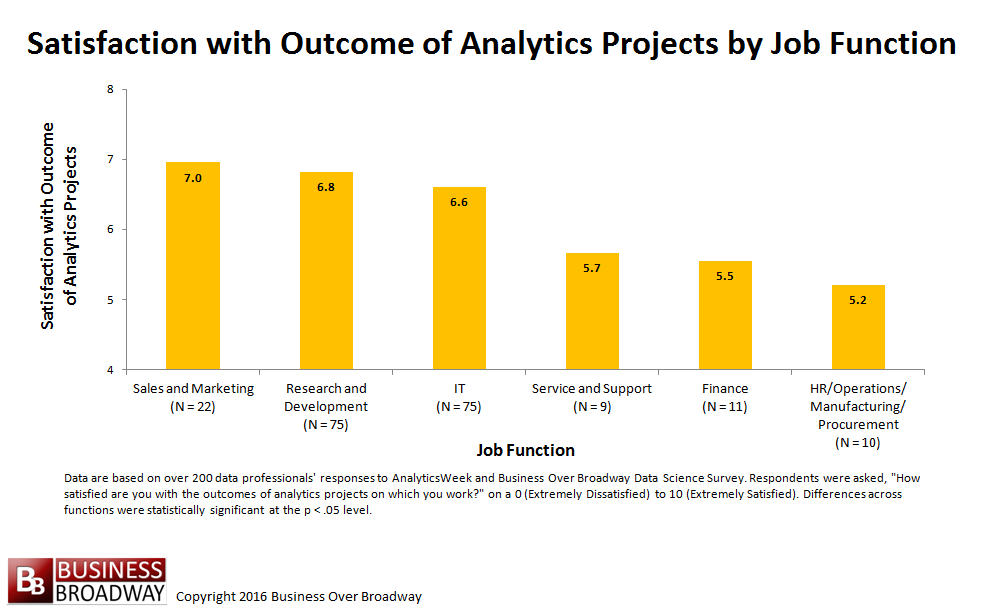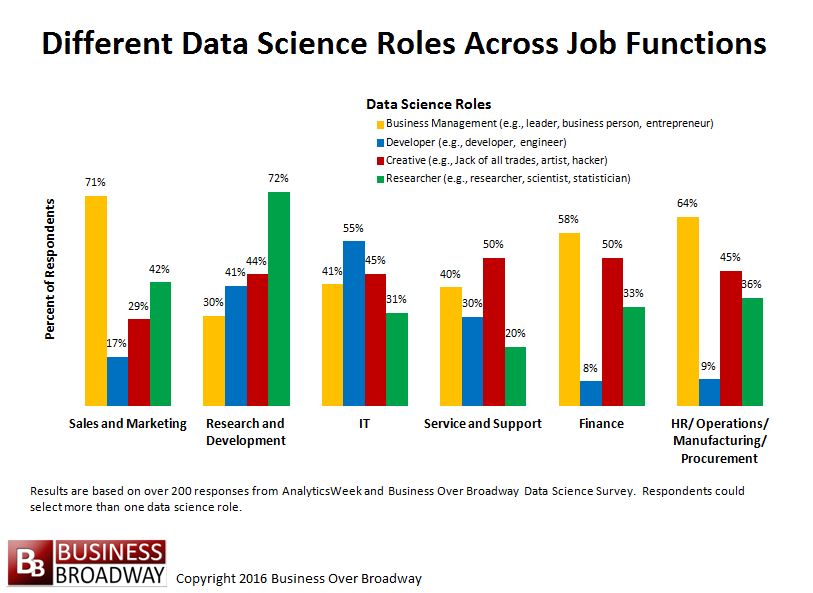The AnalyticsWeek and Business Over Broadway Data Science Survey survey revealed job function differences in data science roles, proficiency in data science skills and satisfaction with work outcomes. Most data scientists work in IT (38%) and R&D (36%) functions. Data scientists who work in Sales and Marketing, Research and Development and IT functions are more satisfied with the outcome of their analytics projects. Data scientists within these job functions have the highest proficiency in Business, Statistics and Technology skills, respectively.

We asked over 200 data professionals about themselves and what they do. We captured their proficiency across three broad data science skills : Business, Technology and Math/Statistics. We also asked about the roles that these data scientists play: Business management, Developer, Creative and Researcher. Finally, we asked them about their satisfaction with the outcomes of projects on which they work.
Results revealed that many of the data scientists work in IT (38%) and Research and Development (36%) functions at work (see Figure 1).
Satisfaction with Outcomes of Analytics Projects Across Job Functions

There was a statistically significant difference in satisfaction with outcomes (see Figure 2). Data scientists who work in Sales and Marketing, Research and Development and IT functions reported the highest level of satisfaction with project outcomes. On the other hand, data scientists who work in Finance and HR/Ops/Mfg/Pro functions reported the lowest level of satisfaction with project outcomes. To better understand why data scientists in some job functions report higher levels of satisfaction than others, I examined their job roles and skill proficiency.
Data Science Roles Across Job Functions

Data scientists in the Sales and Marketing function are primarily in Business Management roles (71%; see Figure 3). Data scientists in Research and Development functions are primarily Researchers (72%). Data scientists in IT functions mostly identify as a Developer (55%). Business data professionals also dominated Finance (58%) and HR/Ops/Mfg/Pro functions (64%). Data Creatives (50%) dominated Service and Support functions.
Proficiency in Data Science Skills Across Job Functions

Next, I looked at proficiency in skills across the different job functions (see Figure 4). In general, data scientists working in the three job functions with the highest level of satisfaction also had the highest level of proficiency across data science skills (average proficiency = 54) compared to the data scientists in the remaining three job functions (average proficiency = 45).
Summary
Survey results showed that nearly 75% of the data scientists come from two job functions: Information Technology (38%) and Research and Development (36%). Additionally, the study results revealed data science differences across different job functions.
Data scientists who work in Sales and Marketing, Research and Development functions reported the highest level of satisfaction regarding outcomes of their analytics projects compared to data scientists who worked in Service and Support, Finance and HR/Ops/Mfg/Pro functions. One reason for this difference could be related to the skill sets of the data scientists in specific job functions.
High satisfaction in some job functions could be due to the data scientists who work in those functions. Previously, we found that data scientists’ skill proficiency was positively related to satisfaction with outcome of analytics projects; data scientists with higher proficiency in data skills were happier with the outcome of their analytics projects. In the current study, data scientists in the high-satisfaction job functions had the highest levels of proficiency in data science skills compared to their counterparts. Improving satisfaction with analytics projects could be accomplished by improving the skills of the data scientists.
While data scientists work in different job functions, most of them come from a couple of job functions: IT and Research and Development. Job functions can be defined by the profiles and skills of their data scientists. While each job function has data scientists representing all four data science roles, some data science roles are more prominent in some job functions compared to others and data scientists appear to have better skills in some job functions compared to others. A better understanding of the possible reasons (e.g., skill proficiency, maturity of analytics use, data science methods/practices) behind these job function differences can help companies build better teams with the right mix of data scientists for their function and help recruiters find the best data science candidates for those job functions.



